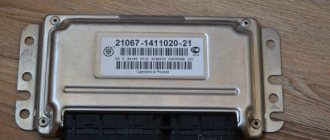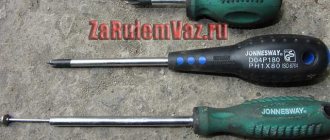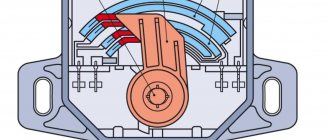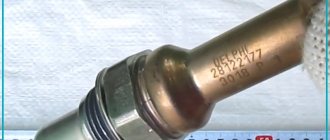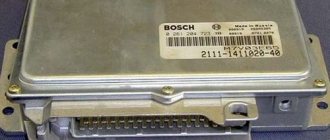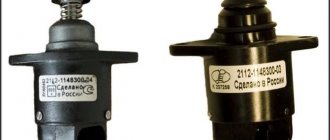If you are faced with a situation where the engine idles unevenly or the car periodically stalls for unclear reasons, then the culprit for this behavior of the power unit may be a malfunction of the throttle position sensor
. You should not immediately go to a service station, because this problem can be eliminated on your own.
New throttle position sensor
In this article we will look at the main signs indicating the failure of this sensor, learn how to check the TPS, and also get acquainted with its design. This instruction is suitable for owners of VAZ 2110, 2114, Priora, Kalina and even Renault Logan
.
is a device that is designed to accurately distribute the amount of fuel mixture entering the engine combustion chamber. Its use in modern engines allows increasing the efficiency of the car, as well as increasing the efficiency of the power unit. It is located in the fuel supply system on the throttle valve axis.
This is what the TPS design looks like
Kinds
At the present stage of development of automotive technology, the following types of TPS are presented on the market:
The latter structurally have resistive contacts in the form of tracks along which the voltage is determined, while non-contact ones carry out this measurement based on the magnetic effect. Sensor differences are characterized by their price and service life. Contactless ones are more expensive, but their service life is noticeably longer.
Operating principle
As mentioned above, the sensor is located near the throttle valve
.
When you press the pedal, it measures the output voltage. In the case when the throttle valve is in the “closed” position, the voltage in the sensor is up to 0.7 Volts
.
When the driver presses the gas, the throttle axis rotates and accordingly changes the inclination of the slider at a specific angle. The sensor response is manifested in a change in resistance on the contact tracks and, consequently, an increase in the output voltage. When the throttle is fully open, the voltage is up to 4 Volts
.
The data is for VAZ cars
.
These values are read by the vehicle's electronic control unit. Based on the data obtained, he applies changes to the amount of fuel mixture supplied. It is worth noting that this entire procedure occurs almost instantly, which allows you to effectively select the engine operating mode, as well as fuel consumption.
Checking and replacing the throttle sensor VAZ-2107-20
The throttle position sensor (TPS) is installed on the throttle valve axis and is a potentiometer.
A reference voltage of +5V is supplied to one output of the sensor, and the other is connected to the ground of the controller. From the third output of the sensor - the potentiometer (slider) - the signal for the controller is removed.
If the TPS or its circuits fail, the “CHECK ENGINE” lamp lights up.
In this case, the TPS functions are taken over by the mass air flow sensor, and the idle speed does not fall below 1500 min-1.
Checking the throttle position sensor
To check the supply voltage, disconnect the wire block from the sensor.
Turn on the ignition and use a tester to measure the voltage between terminals “A” and “B” of the wire block. The supply voltage should be about 5V.
To check the sensor, we connect a block of wires to it and, with the ignition on, measure the voltage (the wires of the block can be pierced with thin needles connected to the terminals of a voltmeter) between the sensor terminals “B” (“ground”) and “C” (slider) - it should not be more than 0.7V.
By turning the plastic sector of the drive by hand, we fully open the throttle valve and measure the voltage again - it should be more than 4V.
Turning off the ignition, disconnect the wire block and connect an ohmmeter between terminals “C” and “A” (or “B”) of the sensor.
Slowly turning the drive sector, we monitor the readings of the tester arrow. There should be no jumps in the needle throughout the entire working range.
To replace the sensor, remove the throttle body from the receiver studs without disconnecting the coolant inlet and outlet hoses from it (see Removing the throttle body).
With the ignition off, disconnect the wire block from the sensor.
Using a Phillips screwdriver, unscrew the two screws securing the sensor to the throttle body
The sensor is marked 2112-1148200
Remove the sealing foam ring installed under the sensor
Install the sensor on the throttle body in reverse order.
In this case, the damper must be in the closed position. The tightening torque for the sensor mounting screws is 2 Nm.
Source
Checking TPS
Checking the throttle position sensor for VAZ 2110, 2114, Priora, Kalina, Renault Logan , etc. cars is carried out as follows:
- Turn off the car ignition;
- Use a voltmeter to check the sensor voltage, which is about 0.7 Volts when the damper is closed;
- Measure the output voltage with the damper fully open. It should be about 4 Volts;
- Check the uniformity of the voltage change by turning the sensor slider. In this case, there should be no jumps in values.
If there are deviations in the received data, the part must be replaced with a new one. In cases where the values coincide, the sensor is working and the breakdown should be looked for in other sensors.
Throttle sensor for VAZ 2107 car injector
Initially, VAZ-2107 models were produced with carburetors, and only from the beginning of the 2000s cars began to be equipped with injectors with an electronic control unit (ECU). This required the additional installation of measuring instruments for various purposes, among which there is a VAZ-2107 injector throttle position sensor (TPDZ).
VAZ 2107 car:
How to Determine a Malfunctioning Throttle Sensor
Checking the TPS itself is simple, and all you need is an electronic multimeter capable of measuring DC voltage. So, to check the TPS malfunction, you need to follow the algorithm below:
- Turn on the car's ignition.
- Disconnect the chip from the sensor contacts and use a multimeter to make sure that the sensor is receiving power. If there is power, continue checking. Otherwise, it is necessary to “ring” the supply wires in order to find the break point or another reason why the voltage to the sensor is not suitable.
- Set the negative probe of the multimeter to ground, and the positive probe to the output contact of the sensor, from which information goes to the electronic control unit.
- When the throttle is closed (corresponds to the accelerator pedal being fully depressed), the voltage at the sensor output contact should not exceed 0.7 Volts. If you open the throttle completely (fully depress the accelerator pedal), then the corresponding value should be at least 4 Volts.
- Next, you need to manually open the damper (rotate the sector) and at the same time monitor the multimeter readings. They should rise smoothly. If the corresponding value rises abruptly, this indicates that there are worn spots in the resistive tracks, and such a sensor must be replaced with a new one.
What does the DPS do?
The function of the throttle valve is to regulate the amount of air entering the fuel rail. The harder the gas pedal is pressed, the larger the clearance in the bypass valve (throttle) becomes, and, accordingly, the fuel in the injectors is more enriched with oxygen.
READ Government services how to install a cryptocomponent
The TPS records the position of the accelerator pedal, which the ECU “informs” about. When the throttle clearance is 75% open, the unit controller turns on the full engine purge mode. When the throttle valve is closed, the ECU switches the engine to idle mode - additional air flow passes by the throttle. In addition, the amount of fuel currently entering the engine combustion chambers depends on the sensor. The proper operation of the engine depends on the serviceability of this small part.
TPDZ - what is it?
The throttle position sensor signals to the controller what position the throttle valve is in when the accelerator pedal is pressed.
This device allows the controller to more accurately dose and supply the fuel mixture. If the sensor malfunctions, the information is transmitted to the controller in a distorted form. This may cause the engine to malfunction and result in excessive fuel consumption.
The controller registers the location of the throttle valve by changes in voltage. A 0.7 V signal forces the controller to switch to idle mode. If the voltage is less than 0.7 V, this indicates that the damper is completely closed. And if the voltage is about or more than 4 V, then the damper is fully open.
Device
There are two types of throttle position devices for the VAZ-2107. These are contact (resistive) and non-contact type sensors. The first type of device is practically a mechanical voltmeter. Coaxial connection with the throttle valve ensures movement of the contactor along the metallized track. The way the angle of rotation of the axis changes changes the characteristics of the current passed through the device via the cable from the electronic engine control unit (ECU).
Resistive sensor circuit:
In the second version of the non-contact design, the ellipsoidal permanent magnet is located in close proximity to the end of the damper axis. Its rotation causes changes in the magnetic flux of the device, to which the integrated circuit reacts (Hall effect). The built-in board instantly records the angle of rotation of the throttle valve axis, which the ECU informs about. Magnetoresistive devices are more expensive than their mechanical counterparts, but they are more reliable and durable.
Integrated circuit of TPS:
The device is enclosed in a plastic case. Two holes are made in the bead for fastening with screws. The cylindrical protrusion of the throttle body enters the bell of the device. The terminal block of the ECU cable is placed on the side connector.
Signs of sensor malfunction
When the TPS is in good working order, your vehicle operates without uncharacteristic jerking or jerking and quickly responds to pressing the gas pedal. If any of these conditions are not met, then there may be a sensor malfunction. This can be determined by the following signs:
- Starting the engine is difficult both hot and cold;
- Fuel consumption increases significantly;
- When driving, the engine jerks;
- At idle, the speed is often higher than normal;
- The car's acceleration is sluggish;
- Sometimes there are extraneous sounds similar to popping noises in the area of the intake manifold;
- The power unit may stall at idle;
- The Check indicator on the instrument panel blinks or stays on.
Most often, the sensor becomes unusable due to exceeding its service life due to wear-out. The contact group has a coating and, accordingly, it is characterized by wear. Those TPS that operate on a non-contact principle do not have this drawback and, accordingly, last much longer.
In order to finally make sure that it is necessary to replace this part, you need to be able to check the sensor
.
The fuel injection system is the most common and reliable. The operation of the internal combustion engine is stable due to the use of many sensors: idle speed, revolutions, throttle valve position or camshaft position. Unlike carburetor systems, there is no distributor (ignition distributor), and all the work of distributing sparks to the spark plugs is performed by a microcontroller unit.
This block needs to “know” a lot of parameters in order to produce a spark on time and supply the exact dose of the fuel mixture to the cylinders. For this purpose, you need a throttle position sensor (TPS). With its help, the electronic control unit “understands” how much the damper is open. How to check the throttle position sensor yourself if it is faulty? Let's discuss.
Replacing TPS
It should be immediately noted that repair of spare parts can only affect resistive (mechanical) sensors, since electronic devices cannot be repaired. Restoring a worn-out contact track at home is quite problematic and clearly not worth it. Therefore, if it fails, the best option would be to replace it with a new TPS.
Replacing a damaged device with a new throttle sensor is easy. You must have minimal experience handling screwdrivers and electrical connectors.
Experts advise purchasing a new throttle position sensor only from branded manufacturers. In an effort to save money, drivers fall for the bait of sellers of cheap counterfeit products. This puts them at risk of suddenly getting stuck on the road or “stumbling” along the highway, wasting a lot of fuel to get to the nearest service station.
Checking TPS
There are different types of throttle position sensors. If you notice one of the above signs of a sensor malfunction, we advise you to check this engine element. Remember that improper operation of the TPS can lead to poor throttle performance, sudden engine stalling and other problems. As an example, we will give a method for diagnosing a potentiometric TPS. For this we need a voltmeter.
- Disconnect the wiring connector from the throttle sensor.
- Open the throttle valve fully by hand and check for changes in resistance between terminals 1 and 2.
- Check the resistance in three different accelerator pedal positions.
- You can get about 10 ohms of resistance when you press the accelerator fully, from 2 to 10 ohms when you press the throttle partially, and 2 ohms when you release the throttle.
- Check your car's repair manual or read specialized forums to get specific numbers that can tell you whether you need to think about replacing the TPS or whether the results obtained correspond to the normal values set by the manufacturer.
For more information about a detailed check of the TPS and the wiring leading to it, read our article.
Adjusting the throttle valve VAZ 2107 injector
Many car owners remember the time when mainly Zhiguli and Muscovites drove along the country's roads. Their key characteristic was that it was very easy to carry out minor repairs or adjust certain parameters, only armed with a small set of tools. However, the difference between those cars and their modern counterparts was that they had a carburetor fuel supply system. She didn't use electronics, so everything was regulated mechanically.
READ Sims 3 how to install fix
Adjusting the injector yourself
Now everything is different, and adjusting the idle speed is no longer as easy as before. Therefore, now we will try to figure out exactly how to regulate the injector and its idle speed on modern cars.
This is what the car’s “injector” looks like.
This is what people mistakenly call the engine control unit (ECU). Although the “injector” itself consists of several parts: ECU, injectors, sensors, etc.
Sensors in the “injector”
There are different technologies for controlling the fuel supply to the engine. Therefore, some sensors may be missing. The most common sensors in the “injector”:
Adjusting the idle speed on a fuel-injected car
In the case when we are talking about floating engine speeds, stopping the engine when the car is put in neutral gear, or increasing speed when the engine is fully warmed up, this may indicate a malfunction of the idle speed controller or a lean mixture. A similar conclusion can be drawn in the case when the speed on a cold engine is too low.
Idle speed regulator Lifan Solano
In any case, this can all happen due to excessive air supply.
The mixture must be adjusted by a computer that collects data from a number of sensors (we have already written about injector sensors above). For some time, it can open or close the injector valves with the value that is needed for the engine at the moment.
Procedure
The idle speed control is an executive element of the engine (mechanical sensor), and if it is not operating correctly, the light indicating a malfunction will not light up. The regulator is a stepper electric motor including a cone needle. The regulator may be located on the throttle body to ensure a specific level of airflow bypassing the closed throttle body. And it, in turn, is set by the car’s electronic system so that the engine runs stably and evenly, regardless of external factors.
We dismantle the idle air regulator
Additional advice is that you can only adjust engine speed on an engine that has been well warmed up beforehand.
Alternative reasons
Signs of a malfunction of the TPS
Any part fails sooner or later, as evidenced by characteristic signs. TPS is no exception.
Typical signs of a malfunctioning throttle position sensor may include:
- the engine idles at high speed;
- there is clearly high fuel consumption;
- in neutral gear the engine stalls;
- the car jerks when accelerating;
- sometimes the Check Engine indicator may light up and stay on for a long time;
- The engine starts with difficulty.
All these signs indicate that the TPS is faulty and, therefore, requires immediate replacement of the part.
Video - some signs of a malfunctioning throttle position sensor:
Throttle valve maintenance and repair
The damper needs to be cleaned from time to time.
This is due to two factors: READ How to install an iPhone program on your computer
For cleaning you will need:
Instead of solvent, you can use gasoline. However, it should be borne in mind that it will dissolve carbon deposits somewhat worse.
To clean, you will need to perform the following steps:
It must be remembered that the connection diagram for the damper differs on different car models. Before starting work, it is better to look at a photo of the unit disconnected from the engine or study a visual disassembly diagram. This will make the procedure much easier.
What you should not do is work independently with a mechanism that has an electric drive - it can be easily damaged. This also applies to electronic drives (and to an even greater extent).
Also, before the cleaning procedure, you should read reviews about your mechanism model. Some devices do not tolerate soaking in gasoline or solvent and begin to work incorrectly after it. In particular, this happens with the dampers of the Mitsubishi Lancer 9 4G18.
You must understand that often cleaning does not give the desired results and the motor continues to work incorrectly. This only means one thing - the valve is out of order. In this case, it is repaired or completely replaced. If we are talking about an electronically driven damper, the problem may be a malfunction of the control unit.
The following signs may indicate the need for cleaning or malfunction:
Car chip tuning
Chip tuning - this word refers to the simple adjustment of the injector and electronic engine control system in order to improve its performance.
Firmware can prepare the car for the quality of local fuel, certain operating temperature conditions, and also determine exactly how much fuel the engine will consume in normal modes.
Advantages of chip tuning
Among the main advantages that a car receives after such modifications are:
How to flush the throttle on a VAZ 2107?
you need to replace the IAC and flush the throttle on the injector 2107 they said during the injector diagnostics, because RPM jumps at idle
I can’t find information on the internet on how to remove this throttle assembly myself and where it is located and what it looks like. I don’t want to give away a hundred, I’m learning on my own car) help with information, who knows.
The throttle on the receiver is screwed on, and the cable from the gas pedal also connects to it. look for the throttle cable and you will follow it to the throttle valve))) it can be removed with keys and hands, it is also easy to clean)))
Do you need to wash it with chemicals and in a special way? or so with a little cloth under the faucet?
Carburetor cleaner to help you
